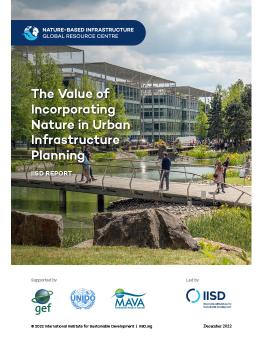
The Value of Incorporating Nature in Urban Infrastructure Planning
Cities around the world are struggling to provide people with the infrastructure they need to thrive. Nature-based infrastructure (NBI) delivers cost-effective, climate-resilient infrastructure services and generates a wealth of co-benefits for citizens, such as reduced air pollution and improved well-being. It also creates an enabling environment for other sustainable infrastructure. To maximize the benefits of NBI, the value of nature must be at the heart of urban infrastructure planning.
This report explores how nature-based infrastructure (NBI) responds to pressing urban challenges and supports the creation of sustainable cities. It starts by illustrating what makes cities sustainable and the potential role of NBI. Next, it summarizes research findings about the value of four NBI types for sustainable urban infrastructure: urban green spaces, green roofs, stormwater infrastructure, and wetlands and lakes. The literature review is complemented by selected NBI case studies that have been assessed with the Sustainable Asset Valuation (SAVi) methodology. Finally, the report concludes by arguing that sustainable cities require strategic, cross-sectoral urban infrastructure planning with nature at its core.
Key messages:
- Urban development—if done unsustainably—is one of the main drivers of biodiversity loss. Population growth in cities makes infrastructure needs in urban areas particularly high and places enormous pressure on the environment. Climate change further exacerbates this impact.
- Building with—rather than against—nature has direct benefits for cities. Nature-based infrastructure (NBI) provides cost-effective and climate-resilient infrastructure solutions and generates a wealth of co-benefits for citizens, such as reduced air pollution and improved well-being.
- NBI in cities is, on average, 42% cheaper and creates 36% more value than relying only on grey infrastructure if avoided costs and co-benefits are taken into account. Case studies by the NBI Global Resource Centre show that for each dollar invested, NBI in cities can generate up to 30 times that amount in returns for society, making investments in urban nature economically viable.
- Building with nature also supports investments in other sustainable infrastructure, such as mobility, water, and energy, by increasing their resilience and effectiveness. Additional research is required to better understand and quantify these benefits and fully leverage nature’s contribution to sustainable cities.
- To make the most of the benefits of NBI, the value of nature must be at the heart of strategic, cross-sectoral urban planning. Planners, policy-makers, and budget holders need to use a systemic perspective to understand how to best maximize the benefits of NBI for sustainable cities.
Participating experts
You might also be interested in
Sustainable Asset Valuation of the Nutrition Sensitive Agriculture Capacity Strengthening Project in Ethiopia
This report analyzes the social, economic, and environmental outcomes of implementing agroforestry and climate-smart agriculture in Ethiopia.
IISD's Best of 2024: Articles
As 2024 draws to a close, we revisit our most read IISD articles of the year.
Sustainable Asset Valuation (SAVi) of a Small-Scale Tree Planting Initiative in Côte d'Ivoire
This report analyzes the social, economic, and environmental outcomes of a small-scale tree planting initiative at schools in Côte d'Ivoire.
The Role of Multilateral Development Banks for Low-Carbon Procurement in the Infrastructure Sector
This report examines the critical role of multilateral development banks (MDBs) in advancing low-carbon procurement within the infrastructure sector.